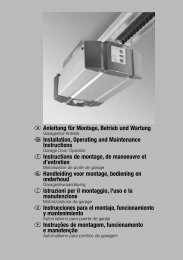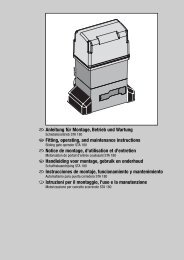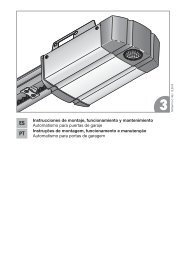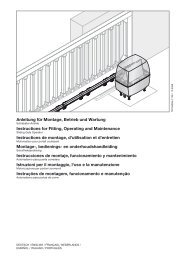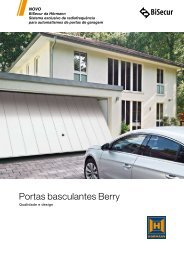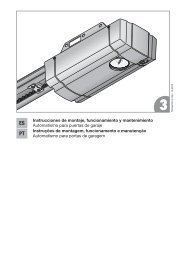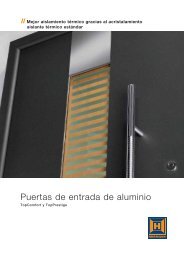Template BA B168xH238 - Hormann.be
Template BA B168xH238 - Hormann.be
Template BA B168xH238 - Hormann.be
Create successful ePaper yourself
Turn your PDF publications into a flip-book with our unique Google optimized e-Paper software.
ENGLISH<br />
5<br />
Initial Start-Up of Basic Equipment,<br />
Gate System Recording the CLOSE<br />
End-of-Travel Position via<br />
Mechanical End Stops or an Electric<br />
Lock<br />
WARNING<br />
Danger of injury during gate travel<br />
If people or objects are in the area<br />
around the gate while the gate is in<br />
motion, this can lead to injuries or<br />
damage.<br />
▶ Children are not allowed to play<br />
near the gate system.<br />
▶ Make sure that no persons or<br />
objects are in the gate's travel<br />
range.<br />
▶ Make sure that no persons or<br />
objects are located <strong>be</strong>tween the<br />
gate and the operator mechanics.<br />
▶ If the gate has only one safety<br />
feature, only operate the gate<br />
operator if you are within sight of<br />
the gate's area of travel.<br />
▶ Monitor the gate travel until the gate<br />
has reached the end-of-travel<br />
position.<br />
▶ Only drive or pass through remote<br />
control gate systems if the gate is in<br />
the OPEN end-of-travel position!<br />
Note:<br />
We recommend fitting a mechanical end stop for the CLOSE<br />
end-of-travel position. This has the following advantages:<br />
• The leaves are positioned tightly against the end stop<br />
and cannot <strong>be</strong> moved by the wind.<br />
• An electric lock provides the system with additional<br />
protection against vandalism.<br />
• In double-leaf systems, the two leaves are exactly flush<br />
with each other in the CLOSE end-of-travel position.<br />
5.1 Single-leaf gate system<br />
5.1.1<br />
Fitting the end stops<br />
5.1.2 Deactivating the integrated limit switch<br />
The integrated limit switch must <strong>be</strong> deactivated <strong>be</strong>fore<br />
teaching in the end-of-travel positions via the mechanical end<br />
stops. Make sure that a wire jumper (to <strong>be</strong> provided on site) is<br />
connected at plug 5/6 instead of the BN/WH wires of the limit<br />
switch (see Figure 5.5b).<br />
5.1.3 Fitting and connecting the electric lock *<br />
▶ See Figure 6<br />
The polarity does not have to <strong>be</strong> taken into account if<br />
connecting electric locks from the accessory list.<br />
5.1.4 Preparations<br />
▶ See Figures 8a/8a.1<br />
1. Uncouple leaf A and open approx. 1 m, re-couple leaf.<br />
2. Set all DIL switches to OFF.<br />
3. Connect the power supply.<br />
4. DIL switch 1 to ON = single-leaf system<br />
5. DIL switch 4 to ON = set-up mode<br />
a. Green LED GN flashes = set-up mode<br />
b. Red LED RT is illuminated<br />
5.1.5 Teaching in the CLOSE end-of-travel position<br />
▶ See Figure 8a.2<br />
1. Press and hold circuit board button T. Leaf A moves in<br />
the CLOSE direction, comes to a standstill at the end<br />
stop, and the motor switches off.<br />
2. Release circuit board button T.<br />
The gate is now in the CLOSE end-of-travel position.<br />
The LED RT remains on after the end-of-travel position<br />
has <strong>be</strong>en recorded.<br />
Note:<br />
If the gate moves in the OPEN direction, check the motor<br />
connection (see Figure 5.2), if necessary, connect the motor<br />
correctly, perform a factory reset (see section 9.8) and repeat<br />
the steps descri<strong>be</strong>d in this section.<br />
5.1.6 Teaching in the OPEN end-of-travel position<br />
▶ See Figure 8a.2<br />
1. Press and hold circuit board button T and move leaf A<br />
into the desired OPEN position. Release circuit board<br />
button T.<br />
2. If the system overshoots the desired position, press<br />
circuit board button T again to move the leaf back a bit.<br />
The leaf can also <strong>be</strong> moved forward a bit by pressing<br />
circuit board button T again.<br />
3. Once the desired end-of-travel position is reached, briefly<br />
press circuit board button P; the OPEN end-of-travel<br />
position has now <strong>be</strong>en taught in. The LED GN briefly<br />
flashes quickly and then slowly.<br />
4. DIL switch 4 to OFF<br />
a. The connected safety equipment is activated.<br />
b. Operation via radio is possible.<br />
5. Use circuit board button T in press-and-release operation<br />
to trigger three complete gate cycles to teach in the<br />
forces (see section 7.1 and Figure 8a.3).<br />
a. The forces have <strong>be</strong>en taught in if LED GN is<br />
illuminated.<br />
WARNING<br />
Danger of injuries due to faulty safety equipment<br />
In the event of a malfunction, there is a danger of injuries<br />
due to faulty safety equipment.<br />
▶ After the learning runs, the person commissioning the<br />
gate must check the function(s) of the safety<br />
equipment as well as the settings (see section 7.2).<br />
The system is ready for operation only after this.<br />
5.2 Double-leaf gate system<br />
5.2.1<br />
Fitting the end stops<br />
5.2.2 Deactivating the integrated limit switches<br />
The integrated limit switches must <strong>be</strong> deactivated <strong>be</strong>fore<br />
teaching in the end-of-travel positions via the mechanical end<br />
stops. Make sure that a wire jumper (to <strong>be</strong> provided on site) is<br />
connected at plug 5/6 instead of the BN/WH wires of the limit<br />
switch (see Figure 5.5b).<br />
* Accessory, not included as standard equipment!<br />
36 TR10A078 RE / 07.2010





